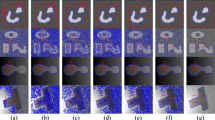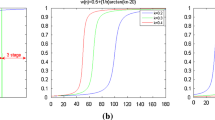Abstract
In this paper, a novel adaptive active contour model based on image data field for image segmentation with robust and flexible initializations is proposed. We firstly construct a new external energy term deduced from the image data field that drives the level set function to move in the opposite direction along the boundaries of object and an adaptive length regularization term based on the image local entropy. The designed external energy and length regularization term are then incorporated into a variationlevel set framework with an additional penalizing energy term. Due to the adaptive sign–changing property of the external energy and the adaptive length regularization term, the proposed model can tackle images with clutter background and noise, the level set function can be initialized as any bounded functions (e.g., constant function), which implies the proposed model is robust to initialization of contours. Experimental results on both synthetic and real images from different modalities confirm the effectiveness and competivive performance of the proposed method compared with other representative models.












Similar content being viewed by others
References
Appleton B, Talbot H (2005) Globally optimal geodesic active contours. J Math Imaging Vis 23(1):67–86
Basaeed E, Bhaskar H, Al–Mualla M (2016) Supervised remote sensing image segmentation using boosted convolutional neural networks. Knowl–Based Syst 99:19–27
Boykov Y, Funka-Lea G (2006) Graph cuts and efficient N–D image segmentation. Int J Comput Vis 70(2):109–131
Chan T, Vese L (2001) Active contours without edges. IEEE Trans Image Process 10(2):266–277
Crandall R (2009) Image segmentation using the Chan-Vese algorithm, Project report from ECE 532, Fall
Ding K, Xiao L, Weng G (2017) Active contours driven by region–scalable fitting and optimized Laplacian of Gaussian energy for image segmentation. Signal Process 134:224–233
Esedoḡlu S, Tsai YR (2006) Threshold dynamics for the piecewise constant Mumford–Shah functional. J Comput Phys 211:367–384
Frieden BR (1972) Restoring with maximum likelihood and maximum entropy. J Opt Soc Amer 62(4):511–518
He C, Wang Y, Chen Q (2012) Active contours driven by weighted region–scalable fitting energy based on local entropy. Signal Process 92(2):587–600
Hojjatoleslami A, Kittler J (1998) Region growing: a new approach. IEEE Trans Image Process 7(7):1079–1084
Kapur JN, Sahoo PK, Wong AKC (1985) A new method for gray–level picture thresholding using the entropy of the histogram. Graph Models Image Process 29:273–285
Kass M, Witkin A, Terzopoulos D (1988) Snakes: active contour models. Int J Comput Vis 1(4):321–331
Kichenassamy S, Kumar A, Olver P, et al. (1996) Conformal curvature flows: from phase transitions to active vision. Arch Ration Mech Anal 134:275–301
Lee S, Seo JK (2006) Level set–based bimodal segmentation with stationary global minimum. IEEE Trans Image Process 15:2843–2852
Li C, Kao C, Gore J, Ding Z (2008) Minimization of region–scalable fitting energy for image segmentation. IEEE Trans Image Process 17(10):1940–1949
Li C, Xu C, Gu C, et al. (2005) Level set evolution without re–initialization: a new variational formulation. Proc IEEE Conf Comput Vis Pattern Recognit (CVPR) 1:430–436
Li C, Xu C, Gui C, et al. (2010) Distance regularized level set evolution and itsapplication to image segmentation. IEEE Trans Image Process 19(12):3243–3254
Li M, Zhan Y (2016) Integrating feature direction information with a level set formulation for image segmentation. E Asian J Appl Math 6:1–22
Li Z, Liu C (2009) Gray level difference–based transition region extraction and thresholding. Comput Electr Eng 35(5):696–704
Liu B, Cheng H, Huang J, Tian J, et al. (2010) Probability density difference-based active contour for ultrasound image segmentation. Pattern Recognit 43(6):2028–2042
Liu C, Liu W, Xing W (2017) An improved edge–based level set method combining local regional fitting information for noisy image segmentation. Signal Process 130:12–21
Liu G, Liu S, Muhammad K, Sangaiah AK, et al. (2018) Object tracking in vary lighting conditions for fog based intelligent surveillance of public spaces. IEEE Access 6(1):29283–29296
Liu S, Bai W, Liu G, Li W, et al. (2018) Parallel fractal compression method for big video data 2018:2016976
Liu Y, He C, Wu Y (2018) Variational model with kernel metric–based data term for noisy image segmentation, Digit. Signal Process 78:42–55
Liu Z, Guo B (2006) New numerical algorithms for the nonlinear diffusion model of image denoising and segmentation. Appl Math Comput 11:380–389
Mumford D, Shah J (1989) Optimal approximation by piecewise smooth function and associated variational problems. Commun Pure Appl Math 42:577–685
Pan Z, Liu S, Fu W (2017) A review of visual moving target tracking. Multimed Tools Appl 76(16):16989–17018
Pan Z, Liu S, Sangaiah AK, Muhammad K, et al. (2018) Visual attention feature (VAF): a novel strategy for visual tracking based on cloud platform in intelligent surveillance systems. J Parallel Distr Com 120:182–194
Paul B, Zhang L, Wu X (2005) Canny edge detection enhancement by scale multiplication. IEEE Trans Pattern Anal Mach Intel 27:1485–1490
Ren Z (2014) Variational level set method for two–stage image segmentation based on morphological gradients. Math Probl Eng 2014:1–11
Sezgin M, Sankur B (2004) Survey over image thresholding techniques and quantitative performance evaluation. J Electron Imaging 13(1):146–165
Shannon CE (1948) A mathematical theory of communication. Bell Sys Tech J 27:379–423
Shattuck D, Sandor S, Schaper K, et al. (2001) Magnetic resonance image tissue classification using a partial volume model. NeuroImage 13(5):856–876
Shiozaki A (1986) Edge extraction using entropy operator. Comput. Vis Graph Image Process 36(1):1–9
Tsai A, Yezzi A, Willsky AS (2001) Curve evolution implementation of the Mumford–Shah functional for image segmentation, denoising, interpolation, and magnification. IEEE Trans Image Process 10(8):1169–1186
Vasilevskiy A, Siddiqi K (2002) Flux maximizing geometric flows. IEEE Trans Pattern Anal Mach Intel 24(12):1565–1578
Vese L, Chan T (2002) A multiphase level set framework for image segmentation using the Mumford–Shah model. Int J Comput Vis 50:271–293
Wang B, Gao X, Tao D, et al. (2014) A nonlinear adaptive level set for image segmentation. IEEE Trans Cybern 44(3):418–428
Wang XF, Huang DS, Xu H (2010) An efficient local Chan-Vese model for image segmentation. Pattern Recognit 43(3):603–618
Wang Y, He C (2012) Adaptive level set evolution starting with a constant function. Appl Math Model 36(7):3217–3228
Wu T, Qin K (2012) Data field–based transition region extraction and thresholding. Opt Lasers Eng 50:131–139
Wu T, Qin K (2012) Image data field for homogeneous region based segmentation. Comput Electr Eng 38(2):459–470
Wu Y, He C (2015) A convex variational level set model for image segmentation. Signal Process 106:123–133
Wu Y, He C (2016) Indirectly regularized variational level set model for image segmentation. Neurocomputing 171:194–208
Xie X, Mirmehdi M (2008) MAC: Magnetostatic active contour model. IEEE Trans Pattern Anal Mach Intel 30(4):632–646
Xu H, Jiang G, Yu M, Luo T (2018) A local Gaussian distribution fitting energy–based active contour model for image segmentation. Comput Electr Eng 70:317–333
Yan CG, Sang N, Zhang TX (2003) Local entropy–based transition region extraction and thresholding. Pattern Recognit Lett 24(16):2935–2941
Yezzi A, Kichenassamy S, Kumar A, Tannenbaum A, et al. (1997) A geometric snake model for segmentation of medical imagery. IEEE Trans Med Imag 16 (2):199–209
Zhang K, Song H, Zhang L (2010) Active contours driven by local image fitting energy. Pattern Recognit 43(4):1199–1206
Zhao F, Jiao L, Liu H (2013) Kernel generalized fuzzy c–means clustering with spatial information for image segmentation. Digit Signal Process 23(1):184–199
Acknowledgements
The authors would like to thank the editor and anonymous reviewers for their helpful and vaulable comments for improving our paper. This work is paritally supported by the National Natural Science Foundation of China (No. 61901292), Scientific and Technological Innovation Programs of Higher Education Institutions in Shanxi (No. 2017141), the Natural Science Foundation of Shanxi Province, China (No. 201801D221186) and School Foundation of Taiyuan University of Technology (No. 2017QN11, No. 2017QN12).
Author information
Authors and Affiliations
Corresponding author
Additional information
Publisher’s note
Springer Nature remains neutral with regard to jurisdictional claims in published maps and institutional affiliations.
Rights and permissions
About this article
Cite this article
Wu, Y., Liu, X., Zhou, D. et al. Adaptive active contour model driven by image data field for image segmentation with flexible initialization. Multimed Tools Appl 78, 33633–33658 (2019). https://doi.org/10.1007/s11042-019-08098-8
Received:
Revised:
Accepted:
Published:
Issue Date:
DOI: https://doi.org/10.1007/s11042-019-08098-8




